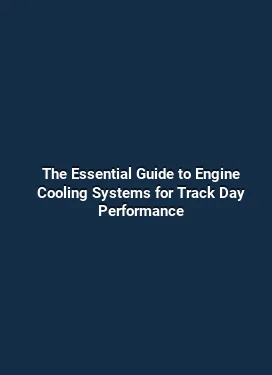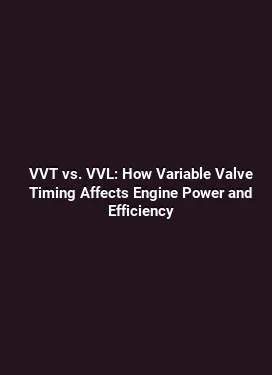Forged Internals 101: Understanding Pistons, Rods, and Crankshafts for High HP Builds
Building a high horsepower engine requires more than just upgrading a turbo or adding aftermarket cams. The core components that translate power into reliable performance are the internal parts that endure the stresses of high RPM, high cylinder pressures, and sustained torque output. Forged internals, specifically pistons, connecting rods, and crankshafts, form the backbone of a durable, capable powerplant. This guide delves into the role of each component, the trade-offs involved in design and material choices, and practical considerations to help you assemble a setup that not only makes impressive numbers on the dyno but also remains reliable on long street sessions or track days.
Pistons: Mass, Strength, and Temperature Management

Pistons are the first line of defense against the chaotic pressure inside the combustion chamber. When forged, they are engineered to resist the fatigue and micro-welding that can occur under boosted conditions or aggressive fueling strategies. A forged piston typically offers improved tensile strength and fatigue life compared to OEM cast parts, enabling higher peak cylinder pressures without premature failure. In high horsepower builds, piston selection centers on a balance between weight, strength, and thermal management.
Key considerations start with material and forging process. Common forged options include hypereutectic aluminum, which blends strength with relatively low weight, and more advanced proprietary alloys that optimize expansion characteristics under high heat. The skirt profile and ring lands are designed to control side loading and to maintain ring seal during rapid pressure swings. The crown geometry, including the piston dish or cavity, is tailored to the compression ratio and combustion phasing of the engine. In forced induction applications, pistons may feature thicker crowns and additional cooling channels to resist knock and detonation while sustaining consistent ring seal across a wide RPM range.
Weight is not a mere target for reducing reciprocating mass; it also affects piston stability at high RPM. A lighter piston reduces inertial forces, improving valve train dynamics and reducing peak piston velocity. However, reducing weight too aggressively can compromise stiffness and ring seal during heavy load transients. Practical approaches include choosing forged pistons with optimized silicone or graphite coatings for reduced wear, and integrating low-tension ring packs to minimize friction without compromising sealing when the motor runs rich or lean under boost. In addition, lubrication pathways, including oil wells and coating strategies, are critical to ensure consistent oil film during high-G cornering and sustained boost.
To maximize reliability, tuning the piston-to-cylinder clearance is essential. Tighter clearances can improve ring seal and combustion efficiency but demand tighter manufacturing tolerances and a robust oiling system. On the other hand, wider clearances may be favored in engines that experience extreme heat or detonation events, allowing the piston to expand without seizing. The net result is a harmonic balance between thermal expansion, ring sealing, and piston stability through the RPM spectrum you intend to run.
Piston Materials and Forging Techniques

Forging processes such as closed-die forging create highly consistent grain structures that contribute to superior strength and fatigue resistance. The chosen alloy is engineered to withstand carbon buildup, high cylinder pressure, and rapid temperature swings. Surface treatments, including skirt coatings and molybdenum or ceramic-like deposits, reduce scuffing and accelerate heat dissipation during high-load sessions. Advanced pistons may also feature a lubricant-spray coating in the oil control ring grooves to reduce friction and extend life under boosted conditions.
In practical terms, selecting a piston with the right balance of weight, thickness, and ring land geometry can influence how soon you reach peak power and how long the engine can sustain it. It is common to see forged pistons with lower crown mass and reinforced ring lands for boosted street or race engines. Users aiming for reliability under sustained high-HP operation will also consider the compatibility of piston design with a given rod and crank setup, ensuring tolerances line up with the chosen cam timing and fuel system.
Rods and Crankshafts: Connecting High HP to Durability
While pistons bear the brunt of combustion forces, rods and crankshafts are the conveyance that transfers those forces into usable torque. In high horsepower builds, the choice of forged rods and a forged crankshaft is typically driven by the need for superior strength, consistent reliability under high detonation risk, and predictable wear characteristics. The goal is to maintain precise crankshaft journal geometry and rod bearings with minimal flex, even under rapid start-up transients and sustained high RPMs.
Rods come in various shapes and sizes, but the core distinctions in forged options revolve around material quality, cross-sectional design, and big-end bearing dimensions. A forged rod often features a larger beam web and a robust small-end to reduce side-loading and promote smoother piston motion. The weight distribution and rod-to-stroke relationship influence piston acceleration and the overall feel of the engine at the limiter. In turbocharged and nitrous-assisted builds, rod choice becomes critical as cylinder pressure spikes increase the demands on connecting rods. A common approach is to select a rod with a slightly thicker beam and a higher fatigue limit, paired with a tightened rod bearing clearance that accommodates high-temperature operation.
Crankshafts in forged form bring exceptional torsional stiffness and fatigue life to power-focused builds. A forged crank is designed to endure high bending moments and to minimize crank walk or journal wear in harsh operating regimes. Journal geometry, including standard or setback offset and the arrangement of main and rod journals, dictates how the crank handles lateral loads and cross-plane versus flat-plane configurations. In modern high-HP engines, crankshafts are often CNC-machined to exact tolerances, with surface hardening or case-hardening processes to resist micro-chipping and surface fatigue. The result is a crank that maintains oil clearance and bearing integrity even after hundreds of dyno pulls or aggressive track sessions.
Balancing and precision are non-negotiable when it comes to forged cranks. A well-balanced assembly reduces primary and secondary harmonics that can lead to bearing fatigue and rod bolt failure. This is particularly important on high-revving engines where small imbalances escalate with rpm. The balance factor, typically adjusted through a combination of reciprocating weight distribution and dynamic balancing at assembly, ensures smoother operation and improved longevity under high boost or nitrous scenarios.
Rod Design and Crankshaft Geometry Considerations
Rod design emphasizes minimizing side loading and ensuring stable crank throw dynamics. A common practice is to pair forged rods with a chosen stroke to optimize the rod-to-stroke ratio, which influences piston dwell time and the angle of attack at TDC and BDC. A favorable rod ratio can improve high-RPM stability and reduce piston skirt wear under aggressive boost and gearing. In addition, the type of fasteners used in the rod assembly—such as high-strength bolts or studs—affects cap retention under extreme pressure. Proper torquing protocols and grade recommendations are essential to prevent cap loosening during hard launches or long pulls on the drag strip.
Crankshaft geometry, including counterweight mass and neck diameters, plays a vital role in harmonics management. A heavier counterweight can dampen torsional vibrations but adds rotating mass, influencing throttle response and parasitic losses. Some builds benefit from lightened counterweights or optimized fillet radii to improve fatigue life without sacrificing strength. A forged crank often features tight fillet radii and polished journals to minimize micro-wear and ensure consistent lubrication across the journal surface, which is critical under high-heat conditions generated by forced induction.
Practical Integration: How to Match Pistons, Rods, and Crank for Real-World Power
Choosing forged internals is only part of the equation. Real-world performance hinges on integrating pistons, rods, and crankshafts with the rest of the drivetrain and supporting systems. A holistic approach considers fuel delivery, ignition timing, cooling capacity, oiling strategy, and a robust transmission setup capable of handling the horsepower and torque. The goal is to preserve mechanical integrity while pushing for higher output and better efficiency, especially during sustained runs on the track or spirited street driving.
One practical strategy involves aligning the internal components with an optimized lubrication plan. At high power levels, oil pressure stability becomes crucial. Upgraded oil pumps, improved baffles, and proper oil coolers help maintain consistent film thickness across bearings and ring lands. This reduces the risk of bearing wear and ring land failure when the engine operates at elevated temperatures or experiences boost spikes. Additionally, ensuring adequate oiling to the piston skirts and wrist pins helps manage heat and wear in the most dynamic regions of the engine.
Another critical aspect is compatibility with the intake and exhaust systems. Forced induction alters the combustion environment, which influences peak cylinder pressures and the timing window for efficient combustion. Selecting pistons with appropriate crown geometry and ring pack configuration aligns with the targeted compression ratio and boost strategy. Rods and crankshafts should be chosen with a consideration for the engine’s intended rpm range and the tuning approach, whether it is drag-focused with a sharp torque curve or endurance-oriented with a broad, usable power band. The end result is a cohesive assembly that delivers reliable power across the RPM spectrum while maintaining control over detonation susceptibility and thermal stress.
Finally, calibration and break-in procedures are essential. A careful break-in protocol for forged components helps the moving parts settle in and establishes stable bearing oil film formation. This often includes a staged load application, controlled RPM ramping, and precise engine temperature management. Maintenance intervals, oil analysis, and wear monitoring should be standard practice for any high HP build, providing early indicators of wear trends and enabling timely interventions before a minor issue evolves into a major failure.
Practical Checklist for Building Forged Internals
To translate theory into a reliable high-HP engine, follow this practical checklist: verify compatibility between piston crown geometry, ring land design, and bore finish; confirm rod length, big-end bore diameter, and cap retention method; ensure crank journal surfaces are within spec and properly coated or treated; align bearing clearances with lubricating system capacity and anticipated oil pressures; upgrade oiling strategy to support sustained high-load operation; optimize cooling capacity to handle elevated temperatures; implement a balanced assembly with precise dynamic balancing; plan for detonation resistance through controlled fueling, ignition timing, and possible water/muelled cooling strategies; and schedule regular maintenance and water/mist tuning checks for continued reliability.
In summary, forged pistons, forged rods, and a forged crankshaft together form a resilient trio that can sustain high horsepower with a greater margin of safety. The best results come from a holistic approach that respects material science, mechanical design, and the practical realities of driving dynamics. With the right combination and careful assembly, a high HP build can deliver exhilarating performance while maintaining dependable operation across road, track, and daily usage.






